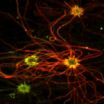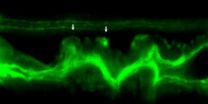This gives key insight to how iron oxide, one of the most abundant minerals in soil, behaves and alters the condition of soil and water around it. This also demonstrates the potential of time-resolved X-ray and optical methods to study chemical reactions at the subnanoscale in other semiconductors.
Scientists have long known that certain minerals, redox active ions and biological proteins can exchange electrons to initiate chemical changes in the mineral. But the process of how electrons hop from atom to atom inside a nanoparticle to facilitate change has been too fast to see until now. The same process controls charge collection in solar energy devices involving metal oxides, and thus this work may have relevance to new energy technologies.
Using the Advanced Photon Source and Center for Nanoscale Materials at the Department of Energy's Argonne National Laboratory, an international team of scientists from Lawrence Berkeley National Laboratory and Argonne, the Technical University of Denmark, Pacific Northwest National Laboratory, and the Polish Academy of Sciences detailed how electrons hop inside iron particles. This plays a significant role in controlling how the iron reacts with the environment.
Iron is an integral part of the natural environment and many important chemical reactions involve changes in iron that are caused by an electron being transferred to the iron from other minerals, water or biological agents. Electron transfer to iron(III) oxides creates iron(II) sites in the mineral. But the iron(II) site is not fixed, as the electron can hop to other sites. Because iron(II) is more soluble than iron(III), when an electron hops to an iron atom at the mineral surface, that iron(II) atom can be released into solution, and dramatically affect the chemistry and mineralogy of soils and surface waters.
Iron reduction is particularly important for the mobility of contaminants in the environment. Because many contaminants, most notably uranium, bind to iron, the change also can affect the spread of these contaminants. A soluble form of iron will help spread the contamination while iron with larger particles can be used to trap contaminants in filter systems. Knowledge of how fast iron oxides undergo reaction and dissolution – controlled in part by the electron hopping rates – will help the management of some contaminant remediation efforts.
"We believe that this work is the starting point for a new area of time-resolved geochemistry," said Benjamin Gilbert, a scientist at LBNL. "Time-resolved science seeks to understand chemical reaction mechanisms by making various kinds of "movies" that depict in real time how atoms and electrons move during reactions. We have imported some of these ideas and approaches into geochemistry, and are very excited about the future possibilities."
The research team detailed their findings and how they made these "movies" in a paper "Electron Small Polarons and Their Mobility in Iron (Oxyhdr)oxide Nanoparticles" published Sept. 6 in the journal Science.
Electron transfer was only made viewable by recent advances in light source technology that allow scientists to take a quick succession of pictures to track the action of the electron traveling through the iron oxide. The journey takes pico-to-nano-seconds, depending on temperature and the structure of the iron oxide.
"Much like a sports photographer must use a camera with a very fast shutter speed to capture an athlete in motion without blurring, to be able to watch electrons moving, we needed to use a exceedingly short and very bright (powerful) pulse of X-rays," said Jordan Katz, the lead author on the Science paper, formerly of LBNL and now a scientist at Denison University. "For this study, the X-rays were produced at Argonne National Laboratory's Advanced Photon Source."
Because iron oxide is a semiconductor, the research team had to develop a way other than an electric charge to jump-start the process. They adapted a pump-probe technique from research in ultrafast science and also used for nanomaterial photovoltaic materials. First, they used laser light to excite a dye molecule sensitized on the surface of the iron to inject an electron into the iron. They used femtosecond optical transient absorption spectroscopy at the Center for Nanoscale Materials to show that the light-initiated electron transfer was extremely fast – much faster than the thermally-driven electron hopping they sought to measure. Then they captured different instantaneous snapshots of the rapid electron transfer process by using ultra-short pulses of X-rays like the shutter on a camera, collecting a sequence of X-ray spectra that indicated the location of the electrons on the subnanosecond timescale.
This technique can be used to study all types of electron transfer in nature and in synthesized materials such as nanofilms aimed at making solar cells more efficient.
"This opens up studies with many other semiconductor materials," said Xiaoyi Zhang, a scientist at the APS. "The same technique of using a light-induced electron to initiate chemistry can be applied to studies of solar cells, hydrogen generation, catalysis and electrochemical (battery) energy storage. It can provide new insights into how electrons or energy flow inside materials."
The APS is uniquely situated to undertake this type of study.
"We used two different specialties of the APS," said Karena Chapman, a scientist at the APS. "The APS is a scientific hub for understanding dynamic processes in nanoparticles. As the materials we investigate become more complex, we only completely understand them by combining what we learn from several different techniques and beamlines."
Beamline 11-ID-D provides an up-close view of individual electron hops by allowing scientists to look at action on multiple time scales so that they can see all of the processes that underlie electron or energy transfer. Scientists can look at action as fast as 80 picoseconds, or 80 trillionths of a second, and the planned APS upgrade will enable even faster viewing. That will allow scientists to see the final step in the process, the electron being injected from the photosensitized molecule to the iron or another semiconductor. That process takes up to several picoseconds.
At the same time, beamline 11-ID-B, the U.S.'s first and only dedicated pair-distribution-function beamline, provided scientists with more of a global view of the resulting atomic structure, which is out of reach for other techniques. Taken together, all of these techniques provided the most complete picture ever of electron hopping and the transformation of iron (III) to iron (II).
###
For Editors:
The Advanced Photon Source at Argonne National Laboratory is one of five national synchrotron radiation light sources supported by the U.S. Department of Energy's Office of Science to carry out applied and basic research to understand, predict, and ultimately control matter and energy at the electronic, atomic, and molecular levels, provide the foundations for new energy technologies, and support DOE missions in energy, environment, and national security. To learn more about the Office of Science X-ray user facilities, visit http://science.energy.gov/user-facilities/basic-energy-sciences/.
The Center for Nanoscale Materials at Argonne National Laboratory is one of the five DOE Nanoscale Science Research Centers (NSRCs), premier national user facilities for interdisciplinary research at the nanoscale, supported by the DOE Office of Science. Together the NSRCs comprise a suite of complementary facilities that provide researchers with state-of-the-art capabilities to fabricate, process, characterize and model nanoscale materials, and constitute the largest infrastructure investment of the National Nanotechnology Initiative. The NSRCs are located at DOE's Argonne, Brookhaven, Lawrence Berkeley, Oak Ridge and Sandia and Los Alamos National Laboratories.
Argonne National Laboratory seeks solutions to pressing national problems in science and technology. The nation's first national laboratory, Argonne conducts leading-edge basic and applied scientific research in virtually every scientific discipline. Argonne researchers work closely with researchers from hundreds of companies, universities, and federal, state and municipal agencies to help them solve their specific problems, advance America's scientific leadership and prepare the nation for a better future. With employees from more than 60 nations, Argonne is managed by UChicago Argonne, LLC for the U.S. Department of Energy's Office of Science.
DOE's Office of Science is the single largest supporter of basic research in the physical sciences in the United States, and is working to address some of the most pressing challenges of our time. For more information, please visit science.energy.gov.
END



